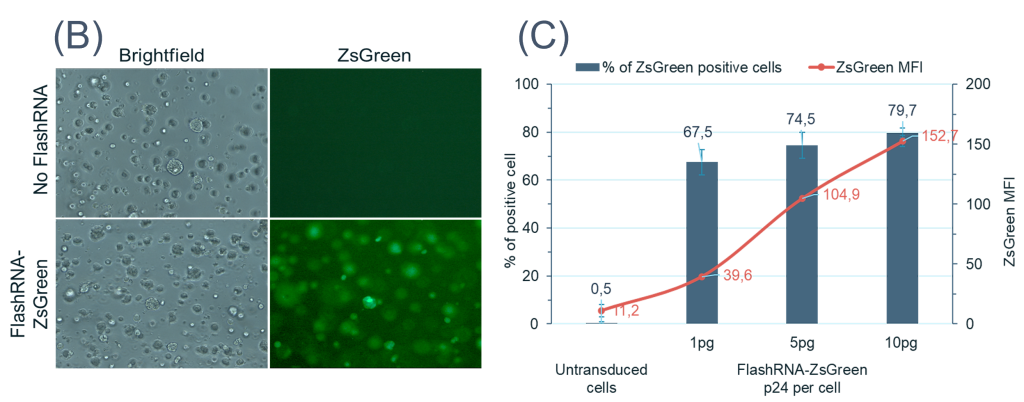FlashRNA® for ORGANOIDS, IN VIVO MODELS, IPSCS, & STEM CELLS
Innovation in the field of gene therapy relies on efficient and safe gene transfer systems capable of meeting the current challenges of biomedical research. FlashRNA®, an advanced technology developed by Flash BioSolutions, is positioned as a promising solution for RNA transfer in organoids, in vivo models, as well as in stem cells and iPSCs, offering new perspectives for the treatment of various pathologies.
The rapid evolution of cell and gene therapy calls for innovative gene delivery systems, able to respond effectively to the various strategies that can be envisaged, from gene expression to gene correction/replacement. Although DNA-based therapies using integrative lentiviral vectors and AAV have become widely available on the market, RNA-based therapies offer greater versatility and cover a wide range of applications with minimal risks. These therapies are particularly well suited to treat or prevent a wide variety of diseases. They are designed for applications where transient expression is safer, such as stimulating a cellular process, modifying a genetic sequence or directing cells towards a specific pathway. Depending on the disease, the delivered RNAs are designed to align with the selected therapeutic strategy, whether gene editing, regenerative medicine or immuno-oncology. RNA optimization varies according to the target cells, the ex vivo or in vivo approach required, the genes of interest, and the intended level and duration of expression.
Organoids are three-dimensional stem cell-derived cell culture systems capable of mimicking the architecture and function of real organs. These miniature organ-like structures are invaluable tools for biomedical research thanks to their ability to closely mimic the in vivo environment. Despite persistent difficulties and the unmet need for new therapeutic strategies, organoids have emerged as a promising animal-free tool, revealing patient heterogeneity and enabling in-depth preclinical therapeutic screening. These tools are revolutionizing drug discovery, personalised medicine, regenerative medicine, and offering new strategies for genetic modification. See the datas.
Flash BioSolutions has developed a revolutionary RNA technology, called FlashRNA®, to transfer RNAs safely and efficiently thanks to its unique features. It can deliver multiple types of RNAs in a highly specific way via a patented encapsulation method. Thanks to a robust multilayer particle, the RNAs are protected from degradation, delivered very efficiently into the cytoplasm of any cell types and immediately available for a rapid translation into proteins, without any risk of cell damage or phenotype alteration. FlashRNA®, which enables precise and efficient control of gene expression and modulation, has demonstrated its ability to transfer RNA and lead to efficient protein expression in organoids to be further used for various studies.
FlashRNA® is thus proving useful for improving the accuracy of disease modelling, drug development studies and screening, and even the development of personalised medicine. FlashRNA® has also demonstrated the ability to edit the genome of iPSCs, without inducing toxicity or adverse effects on their differentiation capacity. This efficient and safe delivery paves the way for its further use for specific applications such as genome editing on pluripotent stem cells and therapy.
In summary, FlashRNA® represents a breakthrough for cell and gene therapy, offering a powerful, safe and flexible delivery system for organoids, iPSCs and in vivo approaches. Its ability to induce efficient and precise genetic modifications positions it as a leading technology for advancing therapeutic strategies, with promising implications for all therapeutic areas. Furthermore, FlashRNA®’s existing cGMP-compliant production capabilities and rapid customization allow to be promptly adapted to a variety of therapeutic needs.
For more data download the poster here.
Human organoids
Collaboration with Urosphere, a preclinical research specialist in urogenital field. This partnership enables us to transduce cancerous bladder organoids with FlashRNA® particles, delivering ZsGreen RNA.
Effectiveness of FlashRNA® transfer in human organoids

(B) Representative brightfield images of human organoids 48 hours after treatment with or without FlashRNA® carrying ZsGreen RNA.
(C) Flow cytometry analysis of ZsGreen expressing organoids treated with a dose range of FlashRNA®. The percentage of ZsGreen cells and mean fluorescence (MFI) are presented (means ± SD, n = 3).
Temporal evolution of organoids treated with FlashRNA®

(D) Reprensentative brightfield images of the evolution of FlashRNA® treated-organoids over time.
Longitudinal morphological analysis of the organoids revealed no significant structural alterations over time in terms of size, cellular density, or aggregation patterns following FlashRNA® transduction. This morphological stability strongly suggests the absence of deleterious effects induced by the gene transfer induced with the FlasRNA® on organoid integrity and development. These observations indicate that FlashRNA® technology enables efficient genetic modification while preserving the three-dimensional structure and functionality of organoids. The maintained structural integrity further supports the biocompatibility of FlashRNA, reinforcing its potential as a safe and effective tool for genetic engineering in complex cellular systems.
FlashRNA® has been shown to have no adverse effects on organoid formation, making it a safe and effective gene delivery tool for transient protein expression and engineering of organoids.
For more data download the poster here.

About FlashRNA® :
FlashRNA® is a non-integrative viral RNA delivery system allowing transient, efficient and safe gene expression which marks a significant milestone in the field of gene and cell therapy. This valuable technology is demonstrated by its non-toxic, non-immunogenic nature, combined with a high uptake due to its viral characteristics and its possibility to deliver multiple distinct RNAs. Its versatility, coupled with a production platform compliant with current cGMPs, opens new avenues for therapeutic approaches, providing additional safety considerations compared to other methods.
Contact info
Nicolas MARTIN
R&D Project Manager
Flash Therapeutics expert since 2006











